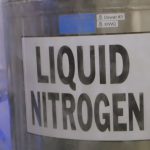New options to rewarm tissue from the vitreous state
A manuscript by Manuchehrabadi et al. about using magnetic nanoparticles to improve rewarming of vitrified tissue samples made quite a splash when it was published earlier this month.
What is the problem that they addressed?
As it turns out, a lot of the tissue damage in vitrification procedures occurs during rewarming, as opposed to cooling.
This is likely due to asymmetry in the rates of ice nucleation (which mostly happens at lower sub-zero temperatures) and ice growth (which mostly happens at higher sub-zero temperatures). This works in our favor during cooling, since most of the ice formation will occur after the point at which most of the ice growth will occur. But it works against us during rewarming, since we get a lot of ice nucleation prior to ice growth.
The end result of this is that the warming rate necessary to prevent ice formation is much higher than the cooling rate necessary to prevent ice formation — around 10-100x to the best of my understanding.
For volumes <3 mL, heat convection is sufficient to rewarm samples at this critical warming rate. But above those temperatures, heat convection isn’t sufficient and ice formation tends to occur during rewarming, which is very damaging to tissues.
Manuchehrabadi et al.’s technology involves introducing silica–coated iron oxide nanoparticles into the samples, which allows them to heat large-volume samples faster via an inductive heating coil. When they used this on 50-mL porcine arteries, it led to a viability improvement of 86 +/- 3%, compared to 20 +/- 6 % viability on the convectively rewarmed samples. Exciting news!
One of my questions here is that it’s unclear how much value the silica–coated iron oxide nanoparticles add over the previously described radiofrequency warming, which has achieved warming rates of 80 °C in kidney tissue. It’d be interesting to see a direct comparison. It’s also unclear whether the nanoparticles can be evenly distributed to a large tissue by perfusion.
Overall, Manuchehrabadi et al.’s findings are promising results in the field of organ cryopreservation. Hopefully, over the next few years the nanoparticle and/or pure radiofrequency approaches can be extended to larger organs, perhaps including vitrified brain tissue samples.
References
Manuchehrabadi N, Gao Z, Zhang J, et al. Improved tissue cryopreservation using inductive heating of magnetic nanoparticles. Sci Transl Med. 2017;9(379)
Wowk B. Considerations for electromagnetic warming of vitrified biomaterials. Cryobiology. 2016;71(1)









